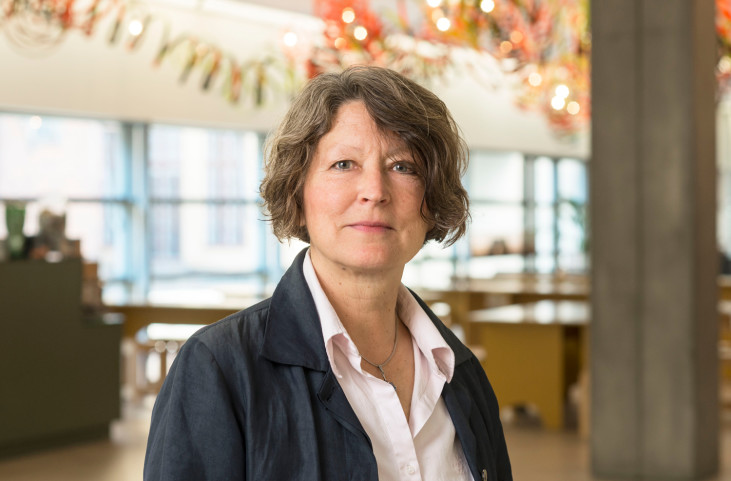
Ann-Sofi Noring and Daniel Birnbaum Photo: Åsa Lundén/Moderna Museet
4.11 2015
5 years with Daniel Birnbaum and Ann-Sofi Noring
How do you feel?
Ann-Sofie: I feel fine. I think we can be proud of how our museums in Stockholm and Malmö are doing right now. The textile artist Hannah Ryggen is a vital political voice on our art scene, and her questions about war and peace are sadly more important now than ever. And in Stockholm, Olafur Eliasson, Francesca Woodman and Lina Selander make a great combination.
Daniel: Stockholm Literature was a success, with voices from all over the world. This is an unusual meeting between art and literature.
Is there anything you’re especially proud of?
Ann-Sofie: We’re the only major art museum in the world with a gender-equal exhibition programme. Considering the male dominance historically and in the collection, this may seem only natural, but no other large museum has worked in this way. It makes you wonder why?
Daniel: Perhaps they’re afraid that only male classic artists will attract enough visitors, although we’re delighted to have disproved that. Our contemporary art is not a problem. But when it comes to earlier periods we need to think harder so we don’t just carry on in the same old rut. Hannah Ryggen is currently getting a lot of attention, not just in Skåne – where she was born – but all over Europe. And our Hilma af Klint exhibition, which has toured to many other places, is actually the most successful exhibition created by the museum ever, in visitor numbers.
Any regrets?
Daniel: We’ve put a lot of effort into achieving a productive relationship with our neighbour, ArkDes. Together, we created an intensive programme of events in the garden, with the visionary Buckminster Fuller, whose futurist dome was filled with jazz and performances for a whole summer. And we’re collaborating now on Olafur Eliasson, but we’re nevertheless stuck in a culture policy vacuum.
Ann-Sofie: We should be able to make each other stronger, or merge into a museum engaging in a wide range of disciplines. That’s the whole idea, you could say, with all the music, dance and literature in the museum. One more government study will hardly generate clarity or enthusiasm.
How is the Moderna Museet collection doing?
Daniel: Moderna Museet has wonderful friends, who understand that a donation to the Museum is a gift to all Swedes. In fact, we are complementing the collection this year in a way that is perhaps unprecedented. And this is currently possible thanks to support from Gunnar Höglund and Anna-Stina Malmborg. Not all public museums can buy an important painting by Sigmar Polke or a key work by Louise Bourgeois, her own favourite sculpture, actually. In 2015, the collection has taken a huge leap.
Ann-Sofie: Yes, and we have begun working on a third Museum of Our Wishes, involving artists with roots in parts of the world that lie beyond Europe and the USA. This will be our big challenge in the coming years. We have one of the finest collections of western modern art. How do we get it to reflect a larger world?
What work of art in the collection is your favourite?
Ann-Sofie: That is truly impossible to answer, but okay: Brancusi’s The Newborn.
Daniel: Today I’ll go for Warhol’s purple flowers.
What’s the future big challenge?
Daniel: We want to stay relevant to a new and growing audience.
Ann-Sofie: It’s not just about art from other continents, but also about diversity in the art created in our own country. Anyone who is curious about this wealth in Sweden will find amazing artists who have been far too invisible, like the abstract painter Madhat Kakei, who was born in Iraq, studied in Bagdad and Madrid, and moved here in the mid-1980s and became a Swedish citizen.
And what about free admission?
Daniel: We don’t know quite yet.
Ann-Sofie: The important thing about free admission is not that the hundreds of thousands who come to the museum anyway won’t have to pay. The big challenge is to reach totally new target groups.
What can we look forward to in 2016?
Ann-Sofie: The year will kick off with an exhibition that brings together two painters who work in the small format: the Swede Ivan Aguéli and the German Paul Klee. Both were influenced by their travels in North Africa and found inspiration in Arabic philosophical traditions.
Daniel: In March, a Hilma af Klint exhibition opens in London. She has become a modern classic.
Published 4 November 2015 · Updated 6 November 2015




















